
|
|
Für die deutsche Fassung bitte nach unten scrollen
|
|
Visit Us at the Salzburger Festspiele!
|
|
|
The preparations are in full swing: After months without any art fairs ART&ANTIQUE in the Residenzhof Salzburg will be worldwide one of the first events where collectors, art lovers and connoisseurs will meet again. We will be the exclusive gallery for ancient art offering millennium-old masterworks with the best provenances. Including the now world-famous Elvis acroterion, the corner piece of a sarcophagus from Roman times that looks astonishingly similar to the King of Rock'n'Roll. When the marble head was auctioned in England 13 years ago, numerous international media celebrated the "Roman Elvis".
|
|
|
|
Our Highlight of the Month:
|
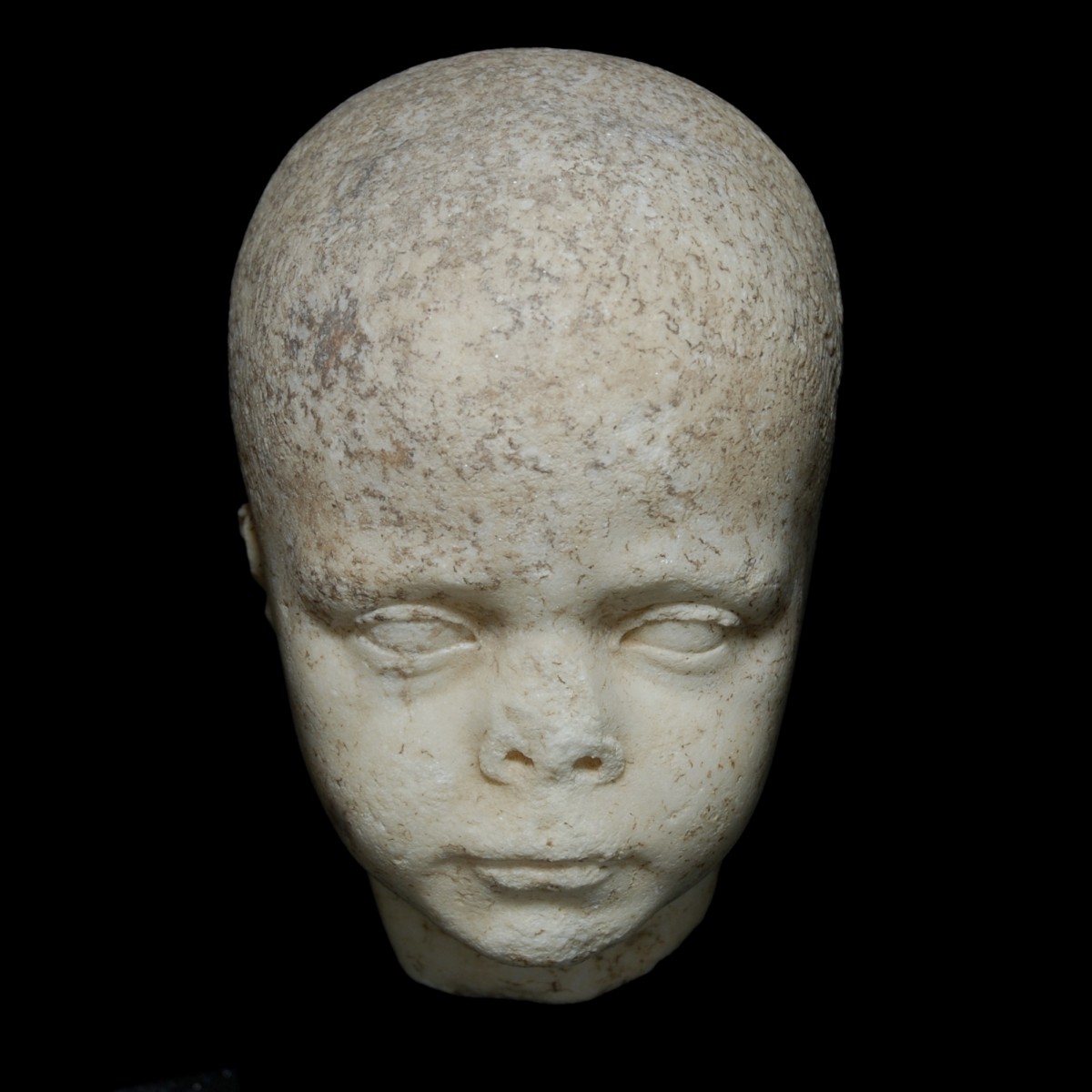
|
|
|
|
|
|
Roman Empire – 1st century B.C. to 1st century A.D.
|
Rare, high-quality and life-size portrait of a boy of about three years old, stylistically dated to the Julio-Claudian dynasty. The childlike proportions with chubby cheeks and the soft features are very well captured. The lively gaze and the slightly pinched mouth with the tight lower lip characterize him as a vigilant observer. The back of the head is dominant and covered by short, wavy hair reaching to the forehead. Numerous root traces, mounted.
|
Provenance: Belgian private collection U.C., acquired in the 1950s. Since then in a diplomatic family estate.
Dimensions: 21 cm high
Price: 28 000 Euro
|
|
|
|
Selected Artworks of the Month:
|

|
|
|
|
|
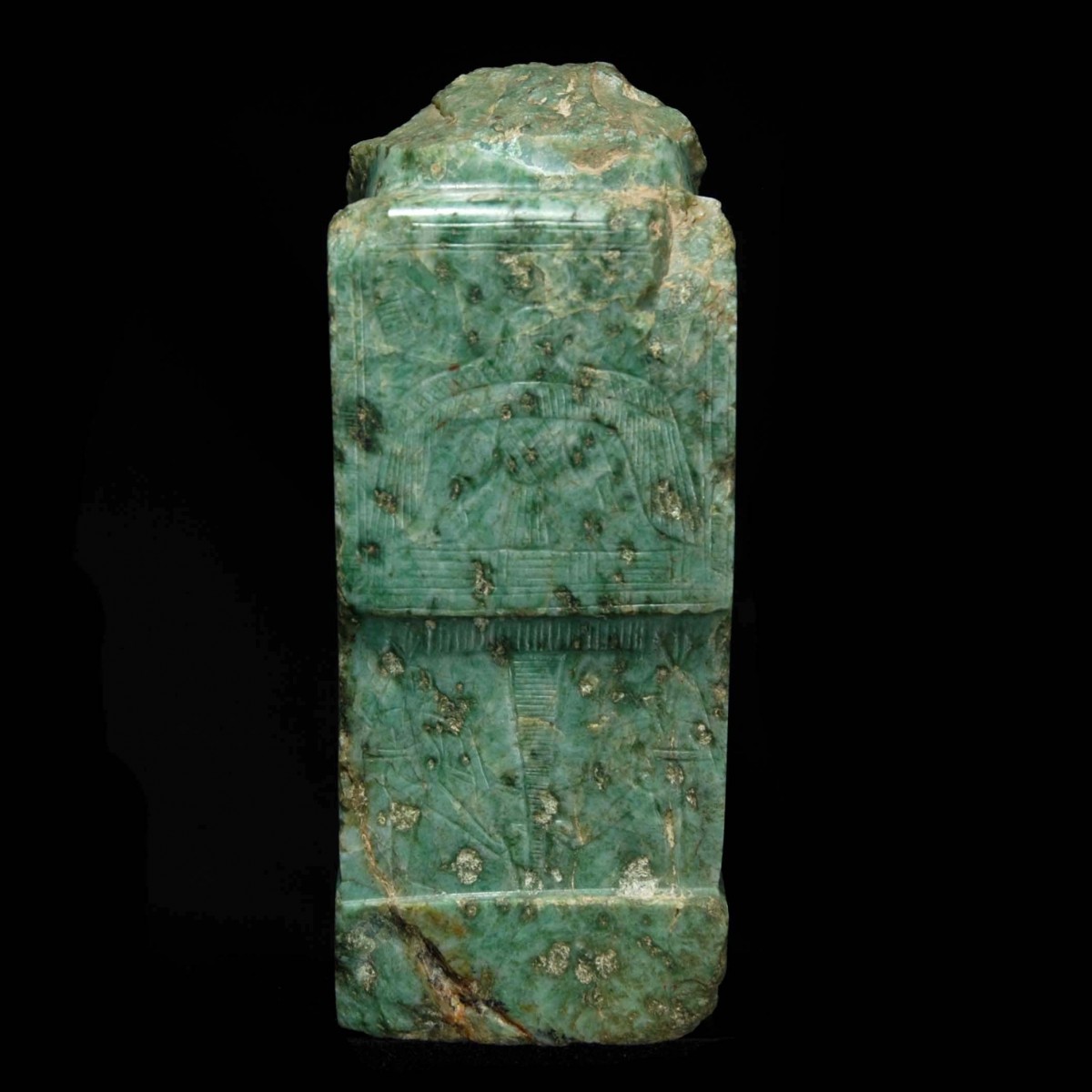
|
|
Egypt – New Kingdom, end of 18th dynasty, 1388-1345 B.C.
|
Extremely rare fragment of a statuette made of anorthosite gneiss, which was only mined in the Old Kingdom and was reused in later times, as in this case. The present object is the remains of a seated statue of a king, possibly Amenhotep III. The ruler is seated on an almost completely preserved throne, decorated on all three sides, dressed with a knee-length apron and a prominent round belly. Furthermore, his lap, parts of his legs and the arms resting on his lap have been preserved. The side walls of the throne are decorated with scales (referencing to the falcon), and in each corner at the back is the symbol for reunification (“Semataui”) of Upper- and Lower Egypt. This is in close connection with the ruling dynasty. The lower end, typical for a throne, is formed by a frieze with ankh signs (symbol for eternal life) alternating with two opposing was sceptres (symbol of power). The back is divided in two. In the upper part, the area of the backrest, there is a falcon deity, possibly Re-Harachte with a sun disk on the head, the shen ring (symbol for eternity and the divine protection of the king) in the claws and spread out wings each with papyrus and feathers. In the lower part the reunification of both halves of the country can be seen, but in greater detail. Two Hapi figures wrap the emblematic plants of Upper- and Lower Egypt, the lotus and papyrus around the trachea of an animal. Due to the material that was no longer mined in the New Kingdom and the decoration of the throne, which clearly emphasizes the reunification of the two countries, it is a rare and important fragment of a seated pharaoh.
|
Provenance: French private collection Garcin, acquired between 1930 and 1950. Thence in a Parisian private collection. Accompanied by a French antiquities passport.
Dimensions: 15.2 cm x 10.5 cm
Price: 18 000 Euro
|
|
|
|
|
|
|
|
|
|
|
Roman Empire – 1st century A.D.
|
Magnificent and large bronze legs of a griffin which once supported an important Roman furniture. The feet with anatomical details, clearly accentuated limbs and long, pointy claws. The legs also with worked out muscles, tendons and joints. The legs are hollow and tapering off on top to an acanthus leaf. Mounted.
|
Provenance: English private collection, acquired 1956. Last in a Scottish auction house.
Dimensions: each 25 cm high
Price: 14 000 Euro
|
|
|
|

|
|
|
|
Egypt – Late period, around 400 B.C.
|
Magnificent fragment of a mummy mask abundantly decorated with gold reliefs. Preserved is the left, centre part with a red closing edge. In the gold relief on top stands a winged Isis with two Maat feathers in the right hand, the left one is raised. In front of her a large, abundantly decorated collar ending in a falcon head with a sun disk. On the right upper edge a hand formed to a fist protrudes into the image area holding the crook. The lower image, separated by three fasciae depicts on the left a standing Osiris with Atef crown and scepter. In front of him lies on a shrine the goddess Hathor in form of a cow with sun disk. From the right side Nut's left wing protrudes into the image area. The goddess also wears a sun disk and holds two Maat feathers in her hand. The cartonnage consists of stuccoed linen and is mounted in an old wood frame.
|
Provenance: German collection M. W., acquired 1999 from the Galerie Roswitha Eberwein in Göttingen, Germany. With original certificate from Roswitha Eberwein.
Dimensions: 33 cm x 20.5 cm; 42 cm x 28.8 cm (frame dimensions)
Price: 9 800 Euro
|
|
|
|
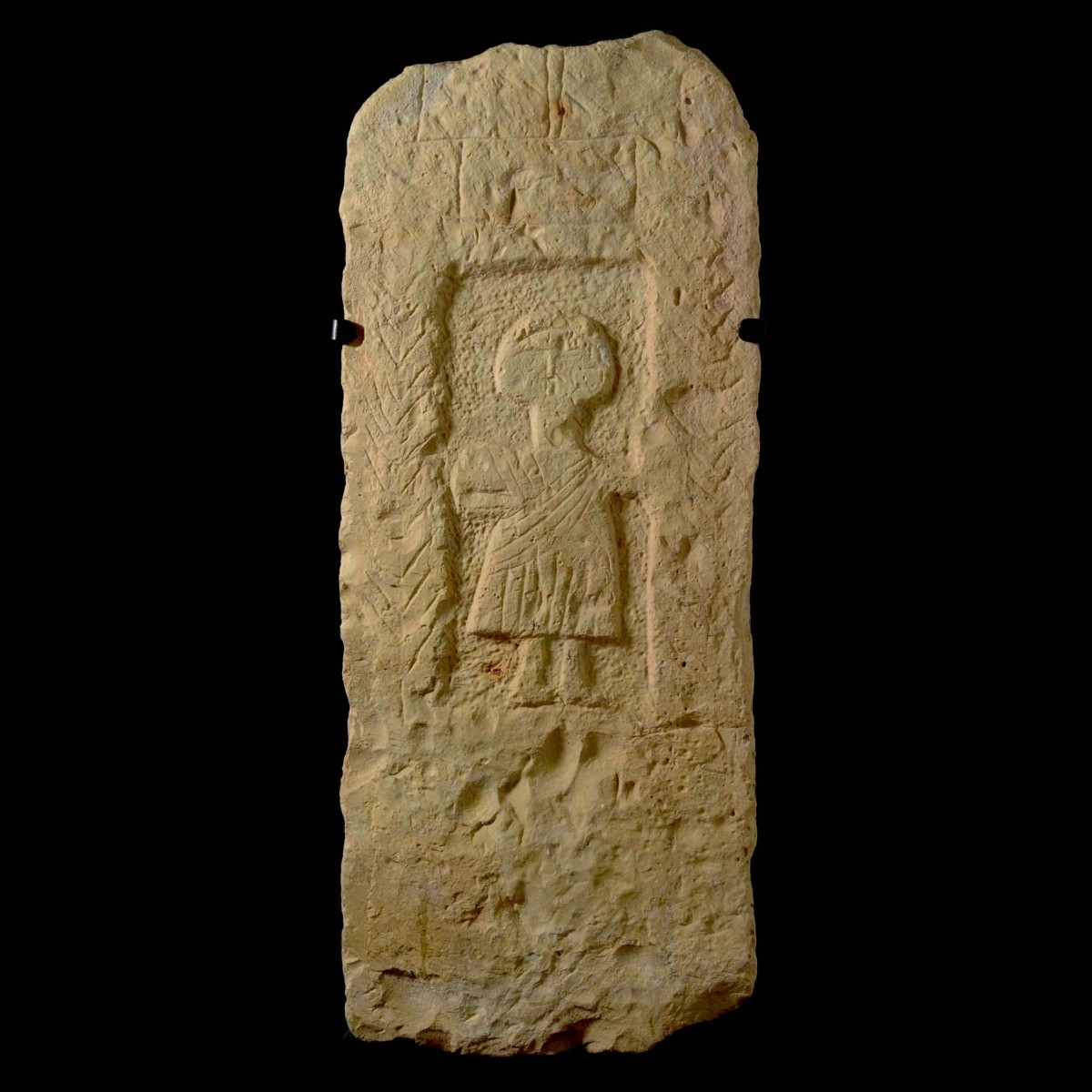
|
|
|
|
Carthago – 2nd-1st century B.C.
|
Large, rectangular limestone stele with a stylized depiction of a man. The figure in flat relief stands on a rectangular indentation. The right arm is bent and placed on the hip. The left arm is stretched outside and holds an object, possibly a floral plant. The man wears a tunic, the bold head with a stylized face. Left and right of the image area herringbone pattern, which also indicates plants. Above engraved rectangles without any identifiable symbolism. Mounted.
|
Provenance: German private collection U. S., Munich, Germany, acquired prior to 1972.
Dimensions: 63.3 cm x 25.3 cm
Price: 6 000 Euro
|
|
|
|
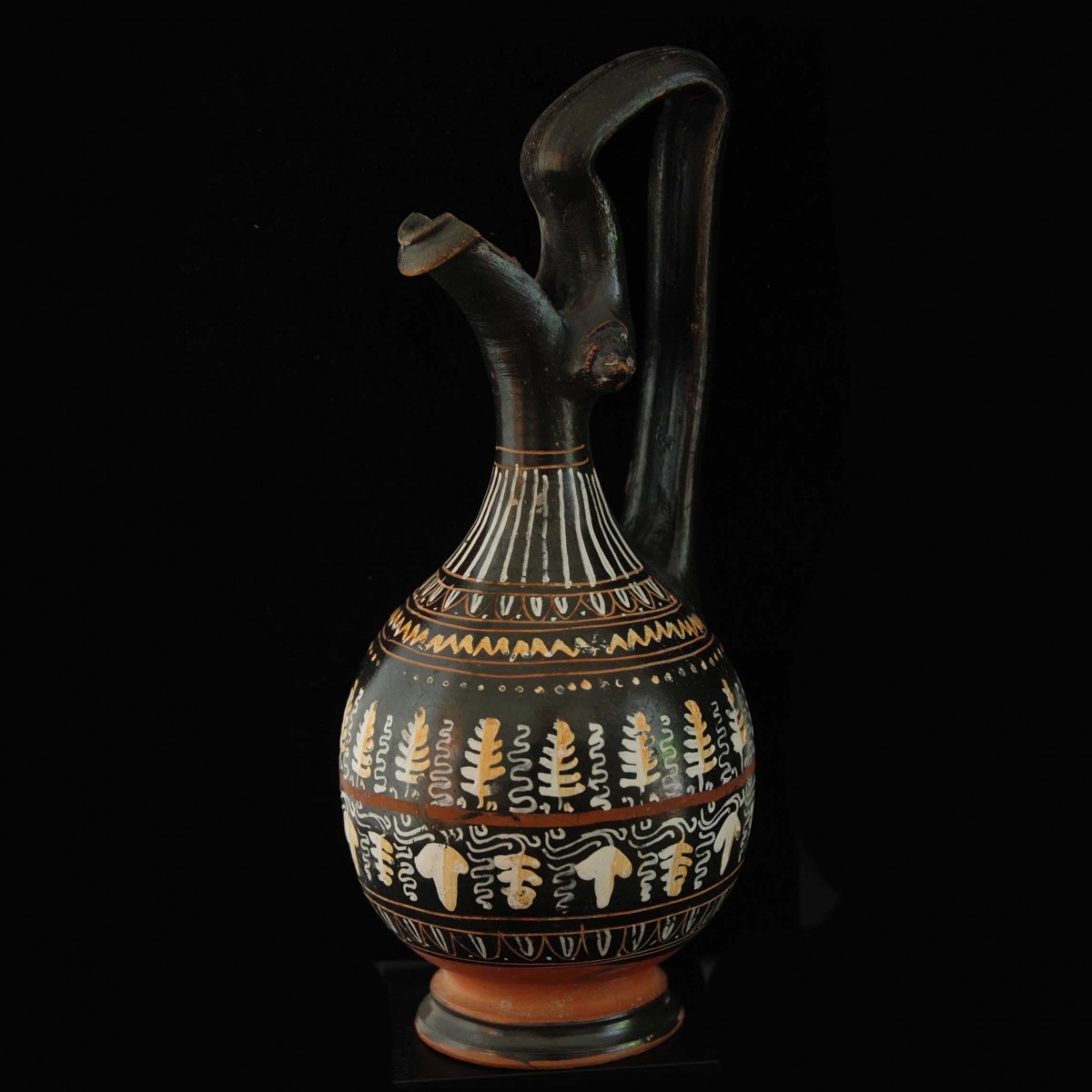
|
|
|
|
Greece/Apulia – Late period, 664-332 B.C.
|
Magnificent epichysis with a beaked spout and high arching handle which reaches the ovoid corpus with a sharp vertical bend. On the beginning of the handle on both sides lionhead applications. The entire jug is completely black-glazed, except for a small area on the ring foot, and painted with white, yellow and red colors. On the neck ray decoration, below egg-and-dart pattern, wave band and dotted decoration. On the corpus itself bicolor leaves and vine tendrils. The ring foot is off set and finely profiled.
|
Provenance: Private collection Professor Dr. Rudolf Leopold (1925-2010), Vienna, Austria. Thence in the family estate.
Dimensions: 16.6 cm high
Price: 1 400 Euro
|
|
|
|
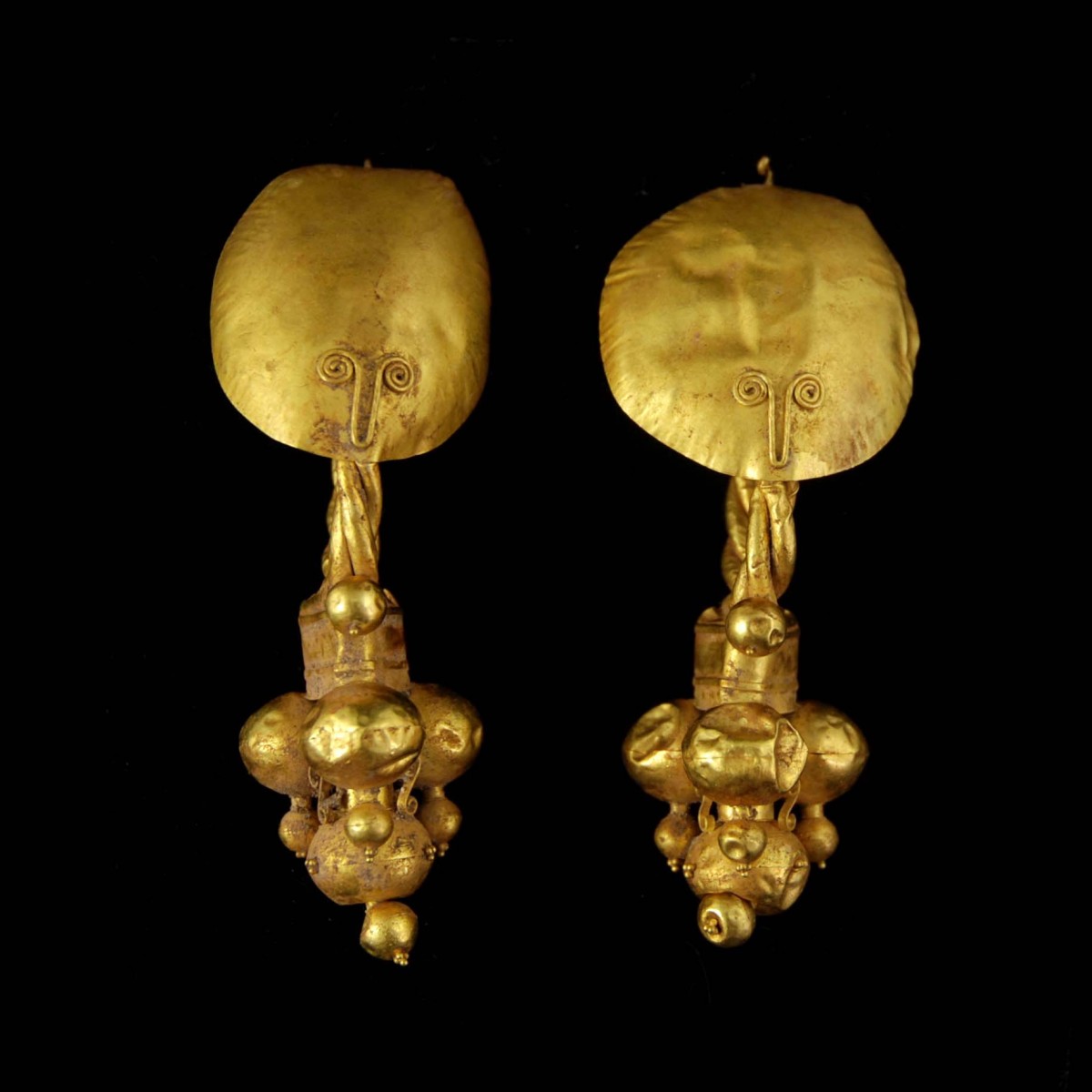
|
|
|
|
Roman Empire – 2nd century A.D.
|
Magnificent gold earrings with large, round shields, with a wire volute at the lower end which creates a stylized face on the shield. At the back an almost straight clamp made of bent gold wires. At the lower end a large grape pendant made of small gold beads which are decorated with granulates and wire volutes.
|
Provenance: Bavarian collection H. I. since the early 1970s.
Dimensions: each 7.5 cm high; 16.7 gram total weight
Price: 4 800 Euro
|
|
|
|
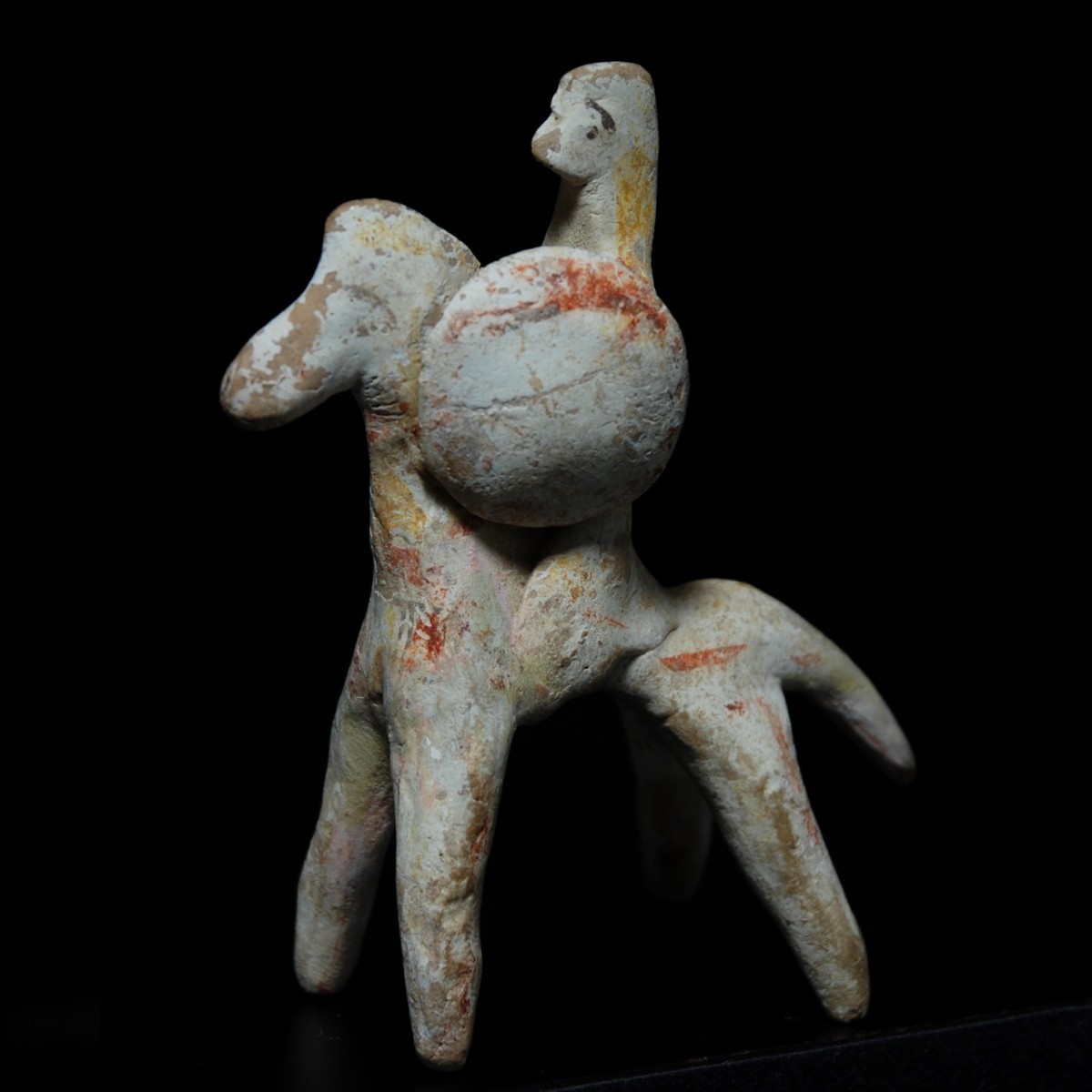
|
|
|
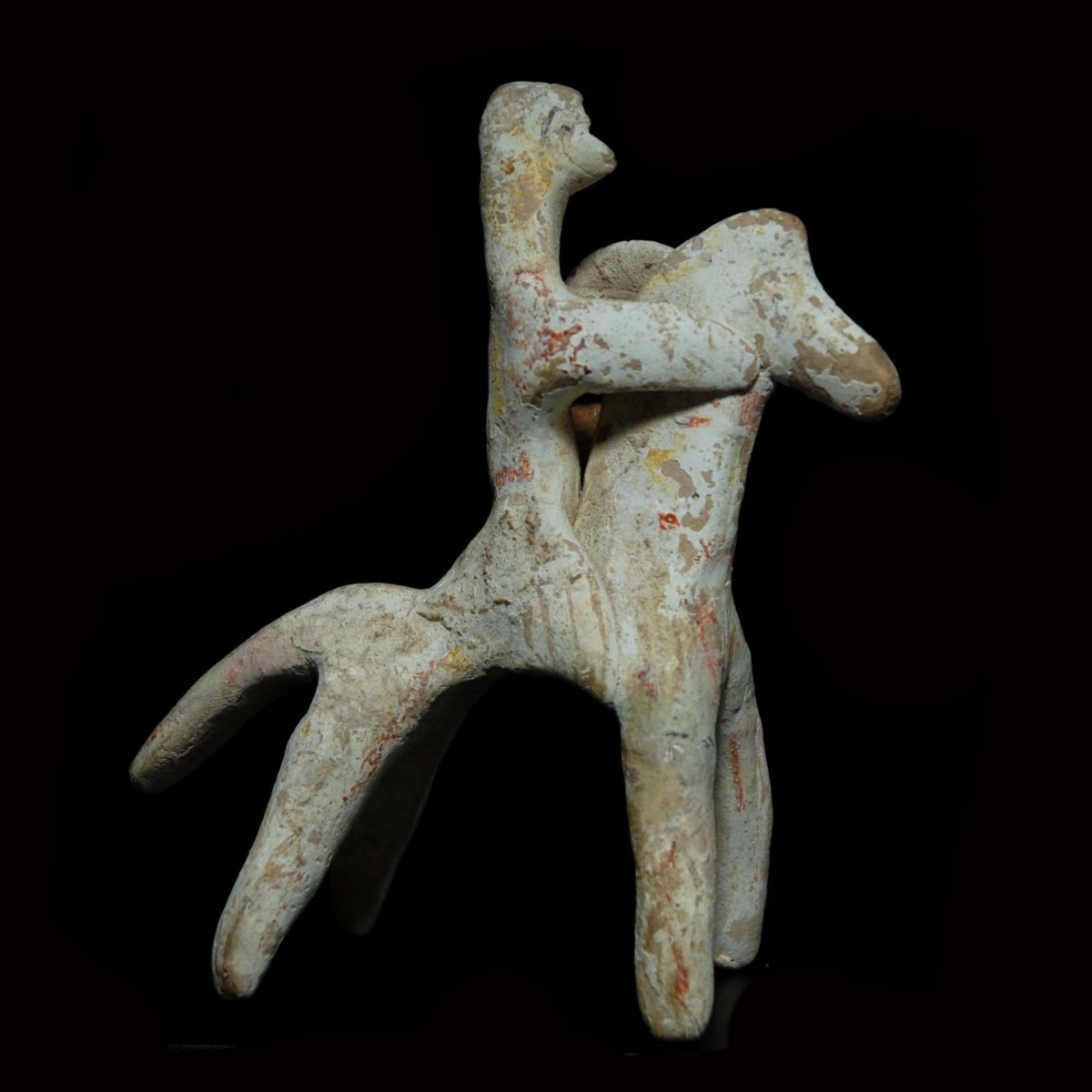
|
|
Greece/Boeotia – 6th century B.C.
|
Handmade statuette of a horse and a rider. The animal with straight legs, a long, slightly bent tail and a raised head with a short mane. The rider places his arms on the horse’s neck, he wears a head cover and holds a shield. His face with painted eyes and brows, as well as a large, bulbous nose. With beautiful white, as well as reddish-brown and black color remains. Statues as the present one originate from a period when owning a horse was attributed to a high social ranking. They were found in graves but also temples. A rare depiction with a shield-holding rider. From Boeotia.
|
Provenance: From the inventory of the judicially dissolved Parisian gallery La Reine Margot.
Dimensions: 10.8 cm x 9 cm
Price: 2 800 Euro
|
|
|
|
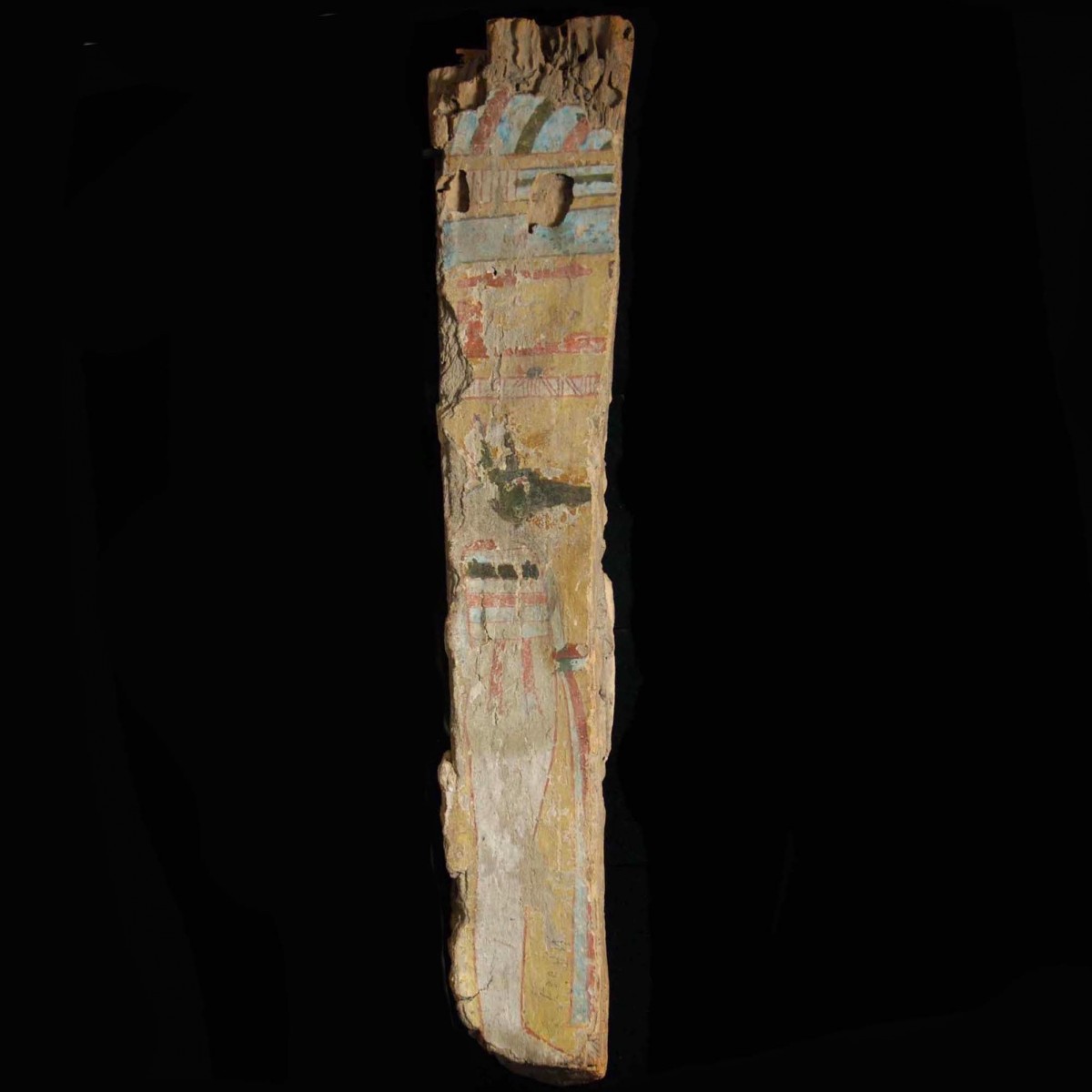
|
|
|
|
|
|
Egypt – New Kingdom, 19th – 20th dynasty, 1292-1070 B.C.
|
Large wood fragment of a sarcophagus painted on both sides with a yellow primer, typical for the period of the late New Kingdom. One side depicts over more than half of its length Horus’ son Duamutef with the black head of a jackal. He wears a white vestment with red, black and light blue ribbons. He holds in front of himself a cascading strips of cloth symbolizing the mummy linen. Duamutef was like his three brothers Imsety, Qebehsenuef and Hapi a tutelary god for the deceased and their helper for the ascent to heaven. Above his head light blue, red and white bands and decoration. On the other side striped long aprons of several persons are recognizable. The finely, almost delicately worked out painting may depict a procession. Almost in the centre an ibis with a black head and white corpus. On top of the panel remains of ancient wood nails. Mounted.
|
Provenance: From the private collection of the French Egyptologist Emile Amélineau (1878-1915). Thence in a French private collection.
Dimensions: 8,2 cm x 43 cm
Price: 1.600 Euro
|
|
|
|
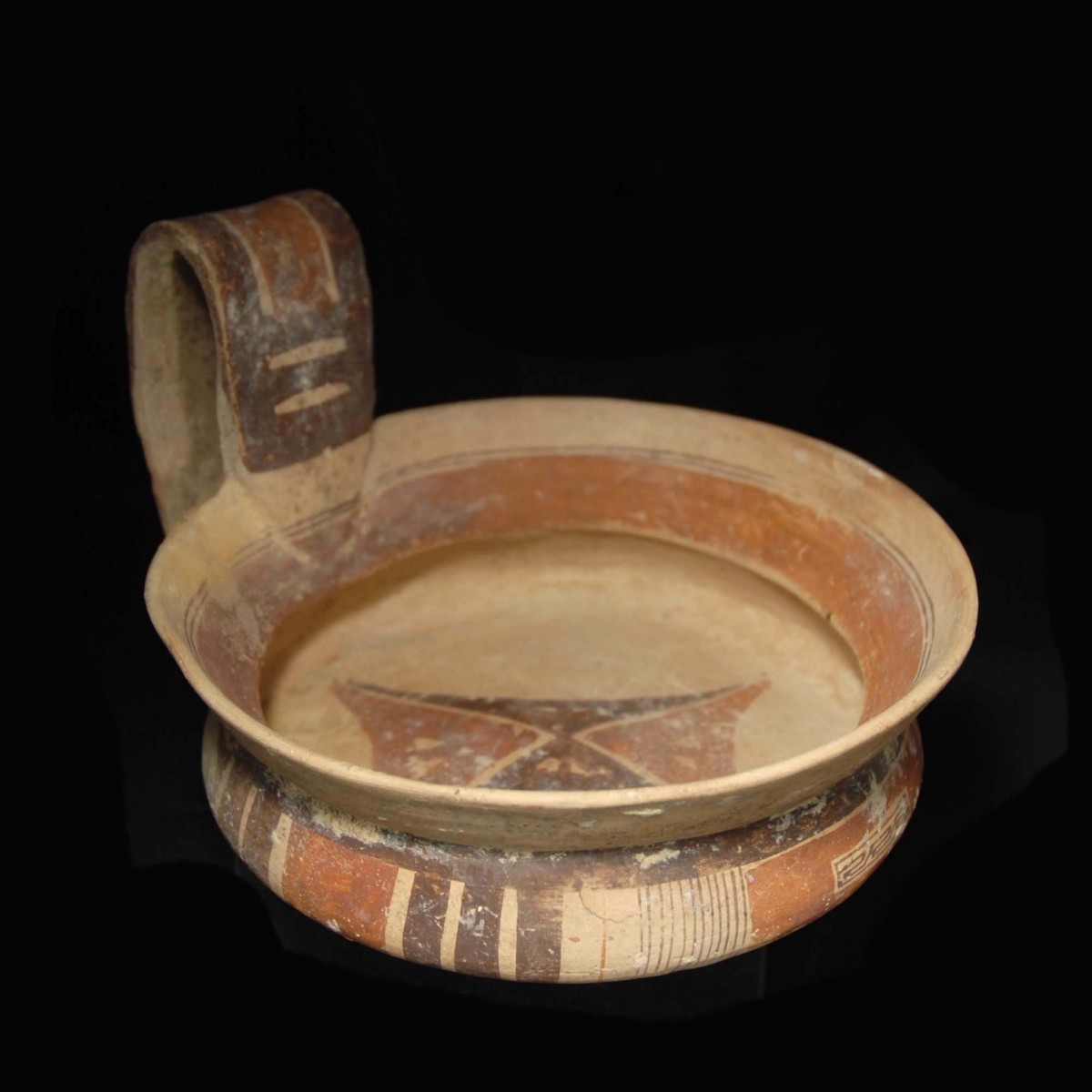
|
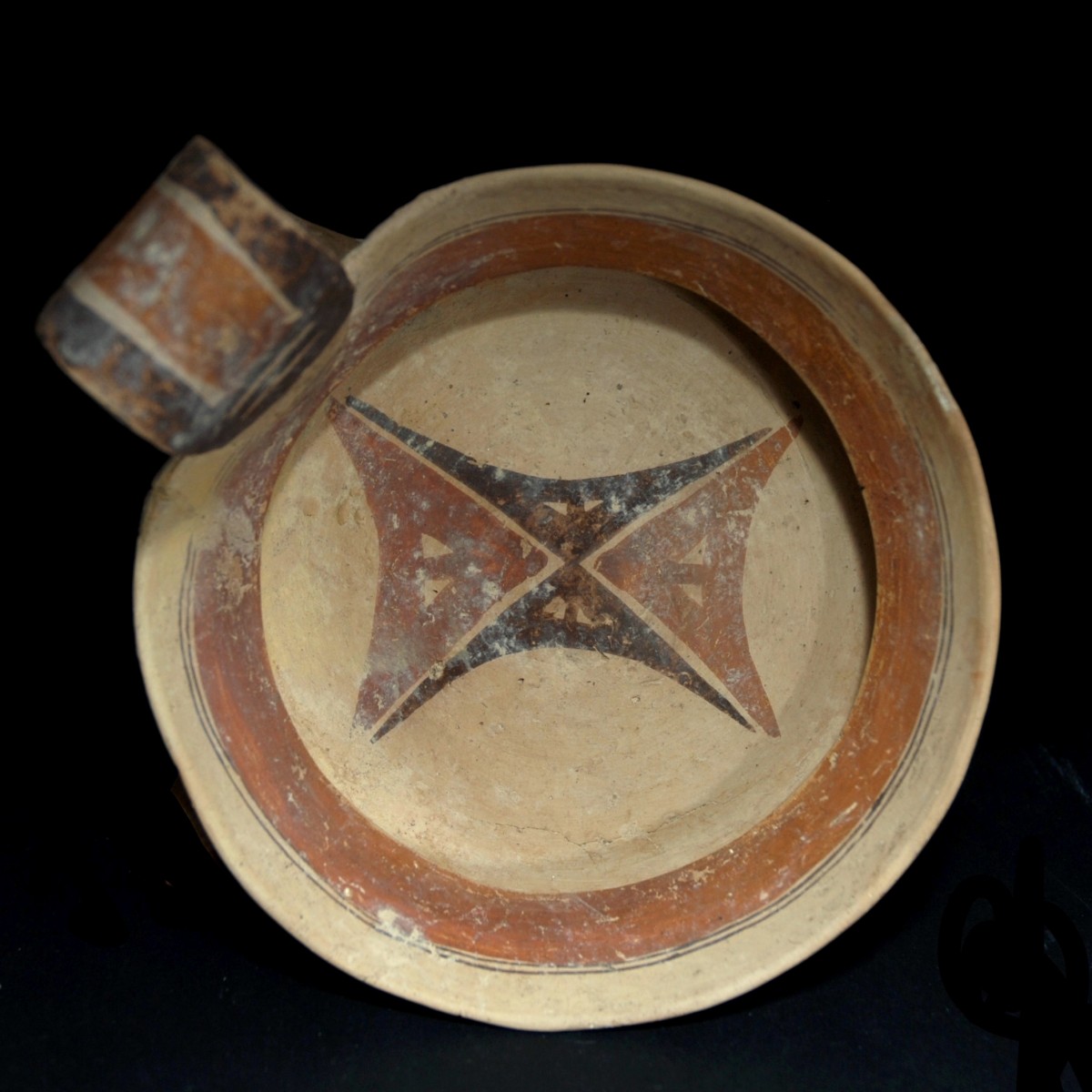
|
|
South Italy – 6th-5th century B.C.
|
Large kyathos on a flat, slightly concave base with red, brown and beige paint. The large round bowl with a corpus rounded outwards and a funnel-shaped rim. A high loop handle, which starts on the rim and reaches to the bottom. The paint outside with stripes and band decoration. Inside a rectangle with inwardly curved sides. The handle decorated with broad bands and the base with a grid pattern.
|
Provenance: Private collection Professor Dr. Rudolf Leopold (1925-2010), Vienna, Austria. Thence in the family estate.
Dimensions: 16.5 cm in diameter; 10.6 cm high
Price: 800 Euro
|
|
|
|
|
|
Besuchen Sie uns bei den
Salzburger Festspielen!
|
Die Vorbereitungen laufen auf Hochtouren: Nach Monaten ohne Kunstmessen wird die ART&ANTIQUE im Residenzhof Salzburg eine der weltweit ersten Veranstaltungen sein, bei der Kunstsammler, Interessierte und Connaisseurs aus aller Welt wieder aufeinandertreffen. Wir werden als einzige Galerie für Kunst der Antike jahrtausendealte Meisterwerke bester Provenienz präsentieren. Darunter das mittlerweile weltberühmte Elvis Akroterion, das Eckstück eines Sarkophags aus römischer Zeit, das dem King of Rock'n'Roll auf geradezu frappierende Weise ähnlich sieht. Als der Marmorkopf vor 13 Jahren in England versteigert wurde, feierten zahlreiche internationale Medien den römischen Elvis.
|
|
|
|
Unser Highlight des Monats:
|
|
Römisches Reich – 1. Jahrhundert v. Chr. bis 1. Jahrhundert n. Chr.
|
Seltenes, hochqualitatives und lebensgroßes Porträt eines etwa dreijährigen Knaben, das stilistisch in die julisch-claudische Dynastie zu datieren ist. Die kindlichen Proportionen mit Pauspacken und die weichen Gesichtszüge sind ausgesprochen gut erfasst. Der aufgeweckte Blick und der leicht verkniffene Mund mit der angespannten Unterlippe charakterisieren ihn als wachen Beobachter. Der Hinterkopf ist noch dominant und von kurzen, welligen Haaren gesäumt, die vorne bereits bis zur Stirn reichen. Zahlreiche Wurzelspuren, gesockelt.
|
Provenienz: Belgische Privatsammlung U.C., erworben in den 1950er Jahren. Seitdem in diplomatischen Familienbesitz.
Höhe: 21 cm
Price: 28.000 Euro
|
|
|
|
Ausgewählte Kunstwerke des Monats:
|
|
Ägypten – Neues Reich, Ende 18. Dynastie, 1388-1345 v. Chr.
|
Überaus seltenes Fragment einer Statuette aus Anorthositgneis, der nur im Alten Reich abgebaut wurde und in späteren Zeiten Wiederverwendung fand – wie im vorliegenden Fall. Wir haben es hier mit den Resten einer Sitzstatue eines Königs, möglicherweise Amenophis III zu tun. Auf dem fast vollständig erhaltenen an allen drei Seiten dekorierten Thron sitzt der Herrscher, bekleidet mit einem knielangen Schurz und einem auffällig rundlichen Bauch. Außerdem haben sich sein Schoß, Teile der Beine und die am Schoß aufliegenden Arme erhalten. Die Seitenwände des Throns sind mit Schuppen (Anspielung auf den Falken) dekoriert und in der jeweiligen hinteren Ecke befindet sich das Symbol für die Wiedervereinigung („Semataui“) von Ober- und Unterägypten. Dieses steht in enger Verbindung zum Herrscherhaus. Den unteren Abschluss, typisch für einen Thron, bildet ein Fries mit Ankh-Zeichen (Zeichen für das ewige Leben) alternierend zu jeweils zwei entgegengesetzt angeordneten Was-Zeptern (Symbol der Macht). Die Rückseite ist zweigeteilt. Im oberen Bereich, dem Teil der Rückenlehne ist eine Falkengottheit vermutlich Re-Harachte mit Sonnenscheibe am Kopf, dem Schen-Ring (Symbol für Ewigkeit und des göttlichen Schutzes des Königs) in den Krallen und ausgebreiteten Flügeln jeweils mit Papyrus und Feder zu erkennen. Im unteren Bereich ist wiederum die Wiedervereinigung der beiden Landeshälften, allerdings ausführlicher wahrzunehmen. Zwei Hapifiguren wickeln die Emblempflanzen von Ober- und Unterägypten, den Lotos und den Papyrus um die Luftröhre eines Tieres. Wegen des im Neuen Reich nicht mehr abgebauten Materials und der Dekoration des Throns, die überdeutlich die Wiedervereinigung beider Länder betont, handelt es sich um ein seltenes und bedeutendes Fragment einer royalen Sitzstatuette.
|
Provenienz: Französische Privatsammlung Garcin, erworben zwischen 1930 und 1950. Danach in einer Pariser Privatsammlung. Mit französischem Antikenpass.
Dimensionen: 15,2 cm x 10,5 cm
Preis: 18.000 Euro
|
|
|
|
|
Römisches Reich – 1. Jahrhundert n. Chr.
|
Prachtvolle und große Bronze-Beine eines Greifen, die einst ein bedeutendes römisches Möbelstück stützten. Die Füße mit anatomischen Details, deutlich akzentuierten Gliedern und langen, spitzen Krallen. Das Bein ebenfalls mit ausgearbeiteter Muskulatur, Sehnen und Gelenk. Die hohl gearbeiteten Beine laufen oben in einem Akanthus-Blatt aus. Gesockelt.
|
Provenienz: Englische Privatsammlung, erworben 1956. Zuletzt in einem schottischen Auktionshaus.
Höhe: je 25 cm
Preis: 14.000 Euro
|
|
|
|
|
Ägypten – Spätzeit, etwa 400 v. Chr.
|
Prachtvolles Fragment einer reich in Goldreliefs verzierten Mumienmaske. Erhalten ist der linke, mittlere Teil mit roter Abschlusskante. Im Goldrelief steht oben eine geflügelte Isis mit zwei Maat-Federn in der rechten Hand, die linke hat sie angehoben. Vor ihr ein großer, reich verzierter Schmuckkragen, der in einem Falkenkopf mit Sonnenscheibe endet. Im rechten oberen Rand ragt eine zur Faust geballte Hand in die Bildfläche, die den Krummstab hält. Das untere, durch drei Faszien abgetrennte Bild zeigt links den stehenden Osiris mit Atefkrone und Zepter. Vor ihm liegt die Göttin Hathor in Kuhgestalt mit Sonnenscheibe auf einem Schrein. Von rechts ragt schließlich der linke Flügel der Nut in die Bildfläche. Die Göttin trägt ebenfalls eine Sonnenscheibe und hält zwei Maatfedern in der Hand. Die Kartonage besteht aus stuckiertem Leinen und ist in einem alten Holzrahmen montiert.
|
Provenienz: Deutsche Sammlung M. W., erworben 1999 in der Galerie Roswitha Eberwein in Göttingen. Mit Original-Zertifikat vom Roswitha Eberwein.
Dimensionen: 33 cm x 20,5 cm; Rahmen 42 cm x 28,8 cm
Preis: 9.800 Euro
|
|
|
|
|
Karthago – 2.-1. Jahrhundert v. Chr.
|
Große, rechteckige Kalksteinstele mit der stilisierten Darstellung eines Mannes. Die Figur im flachen Relief steht in einer ebenfalls rechteckigen Vertiefung. Der rechte Arm ist abgewinkelt in die Hüfte gelegt. Der linke Arm ist nach außen gestreckt und hält einen Gegenstand, möglicherweise ein florales Gewächs. Der Mann trägt eine Tunika, der haarlose Kopf mit stilisiertem Gesicht. Links und der rechts der Bildfläche Fischgrätmuster, das wohl ebenfalls Gewächse andeutet. Darüber eingravierte Rechtecke mit nicht näher bestimmbarer Symbolik. Gesockelt.
|
Provenienz: Deutsche Privatsammlung U. S., München, erworben vor 1972.
Dimensionen: 63,3 cm x 25,3 cm
Preis: 6.000 Euro
|
|
|
|
|
Griechenland/Apulien – Spätes 4. Jahrhundert v. Chr.
|
Prachtvolle Epichysis mit schnabelförmigen Ausguss und hohem Henkel, der steil aufragt und mit einem scharfen Knick senkrecht abfällt und am ovoiden Korpus ansetzt. Am Henkelansatz beidseitig Löwenkopfappliken. Die gesamte Kanne ist bis auf eine kleine Stelle am Ringfußansatz schwarz glasiert und mit weißer, gelber und roter Farbe bemalt. Am Hals Strahlendekor, darunter umlaufend Eierstabmuster, Wellenband und Punktdekor. Am Korpus selbst zweifarbiges Blattwerk und Weinranken. Der Ringfuß abgesetzt und fein profiliert.
|
Provenienz: Privatsammlung Professor Dr. Rudolf Leopold (1925-2010), Wien. Danach weiterhin im Besitz der Familie.
Höhe: 16,6 cm
Preis: 1.400 Euro
|
|
|
|
|
Römisches Reich – 2. Jahrhundert n. Chr.
|
Prachtvolle Ohrringe aus Gold mit großen, runden Schildern, an denen im unteren Bereich eine Drahtvolute sitzt, die dem Schild ein stilisiertes Gesicht verleihen. Auf der Rückseite ein fast gerader Bügel aus tordierten Golddrähten. Im unteren Bereich ein großer Traubenanhänger aus Goldkügelchen, die mit Granulaten und Drahtvoluten verziert sind.
|
Provenienz: Bayrische Sammlung H. I. seit den frühen 1970er Jahren.
Dimensionen: Höhe je 7,5 cm; Gesamtgewicht 16,7 Gramm
Preis: 4.800 Euro
|
|
|
|
|
Griechenland/Böotien – 6. Jahrhundert v. Chr.
|
Handgeformte Statuette eines Pferdes mit Reiter. Das Tier mit geraden Beinen, langem, leicht gekrümmtem Schwanz und erhobenem Kopf mit kurzer Mähne. Der Reiter legt seine Arme an den Hals des Pferdes, er trägt eine Kopfdeckung und ein Schild. Das Gesicht mit aufgemalten Augen und Brauen sowie einer großen, knolligen Nase. Die Beine liegen flach am Körper des Pferdes an. Mit schönen weißen sowie rötlich-braunen und schwarzen Farbresten. Statuen wie diese stammen aus einer Zeit, in der der Besitz eines Pferdes mit einem hohen sozialen Rang verbunden war. Sie wurden in Gräbern, aber auch in Tempeln gefunden. Eine seltene Darstellung mit schildtragendem Reiter. Aus Böotien.
|
Provenienz: Aus dem Bestand der gerichtlich aufgelösten Pariser Galerie La Reine Margot.
Dimensionen: 10,8 cm x 9 cm
Preis: 2.800 Euro
|
|
|
|
|
Ägypten – Neues Reich, 19.-20. Dynastie, 1292-1070 v. Chr.
|
Großes, beidseitig bemaltes Holzfragment eines Sarkophags mit der für das späte Neue Reich typischen gelben Grundierung. Die eine Seite zeigt über mehr als die Hälfte der Länge den Horussohn Duamutef mit dem schwarzen Kopf eines Schakals. Er trägt ein weißes Gewand mit roten, schwarzen und hellblauen Schleifen. Vor sich hält er herabfallende Stoffstreifen, die das Mumienleinen symbolisieren. Duamutef war wie auch seine drei Brüder Amset, Kebechsenuef und Hapi ein Schutzgott der Toten und ihr Helfer beim Aufstieg in den Himmel. Über seinem Kopf hellblaue, rote und weiße Bänder und Dekor. Auf der anderen Seite sind die gestreiften langen Schurze mehrere Personen zu erkennen. Die fein, geradezu filigran gearbeitete Malerei dürfte eine Totenprozession darstellen. Etwa mittig ein Ibis mit schwarzem Kopf und weißem Korpus. Auf der Oberseite des Panels noch Reste der antiken Holznägel. Gesockelt.
|
Provenienz: Aus der Privatsammlung des französischen Ägyptologen Emile Amélineau (1878-1915). Danach in einer französischen Privatsammlung.
Dimensionen: 8,2 cm x 43 cm
Price: 1.600 Euro
|
|
|
|
|
Süditalien – 6.-5. Jahrhundert v. Chr.
|
Großer Kyathos auf flacher, leicht konkaver Basis mit roter, brauner und beiger Bemalung. Die große runde Schale mit nach außen abgerundetem Korpus und trichterförmigem Rand. Ein hoher Schlaufenhenkel, der am Rand ansetzt und bis zum Boden reicht. Die Bemalung außen mit Streifen und Banddekor. Im Inneren ein Rechteck mit nach innen gewölbten Seiten. Der Henkel mit breiten Bändern und der Boden mit einem Gittermuster verziert.
|
Provenienz: Privatsammlung Professor Dr. Rudolf Leopold (1925-2010), Wien. Danach weiterhin im Besitz der Familie.
Dimensionen: Durchmesser 16,5 cm; Höhe 10,6 cm
Preis: 800 Euro
|
|
|
|
|
|
|
CHRISTOPH BACHER ARCHÄOLOGIE ANCIENT ART GmbH
|
Galerie: Stubenring 20, A-1010 Wien
Showroom: Untere Viaduktgasse 55, A-1030 Wien
|
|
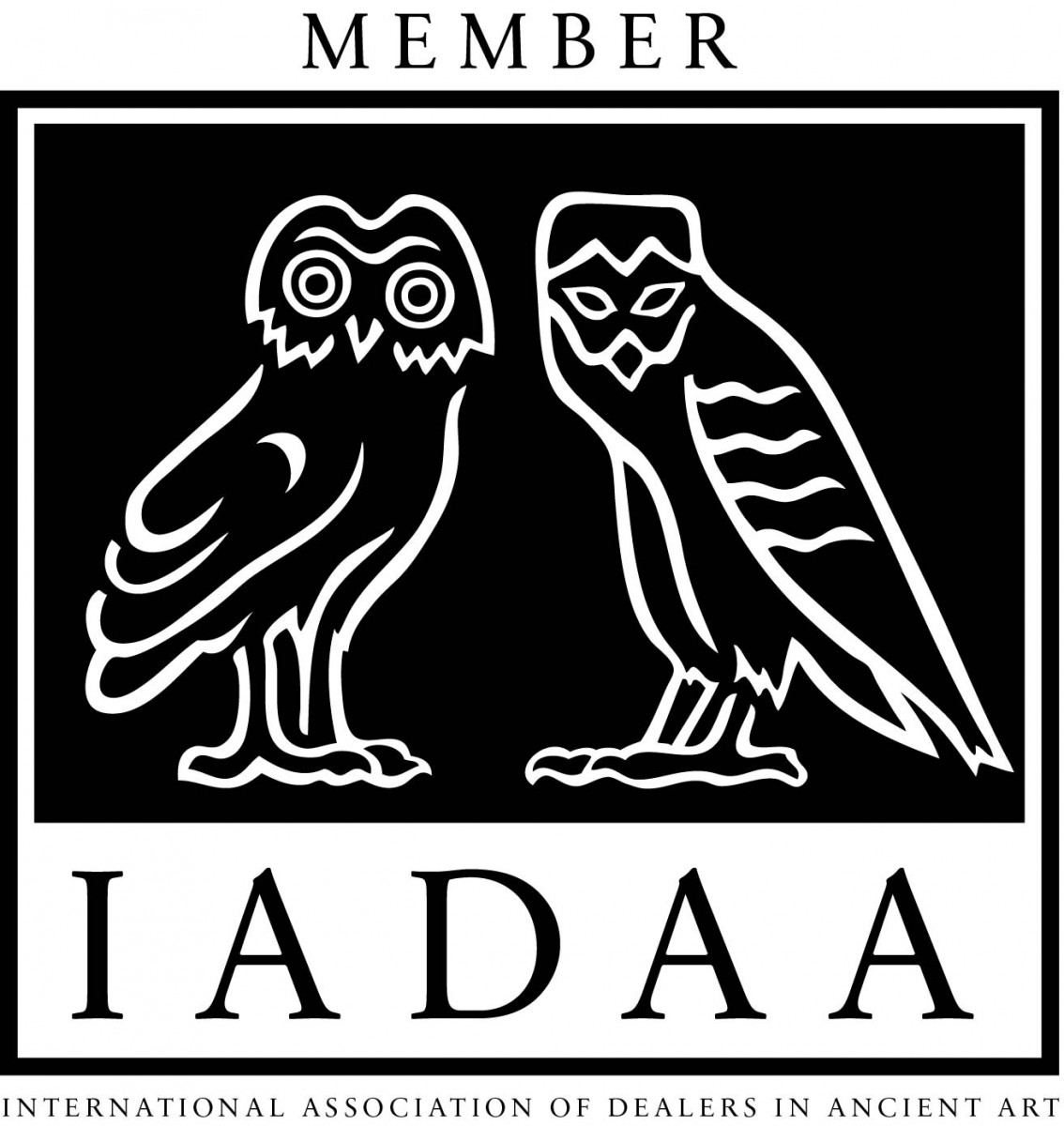
|
|
|
|